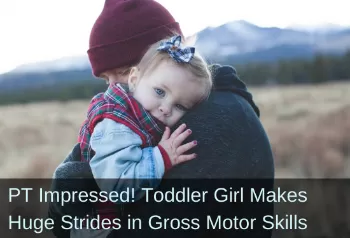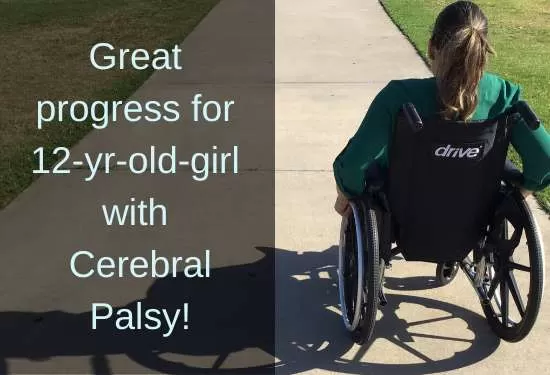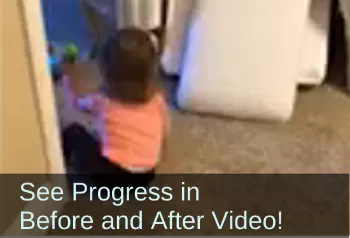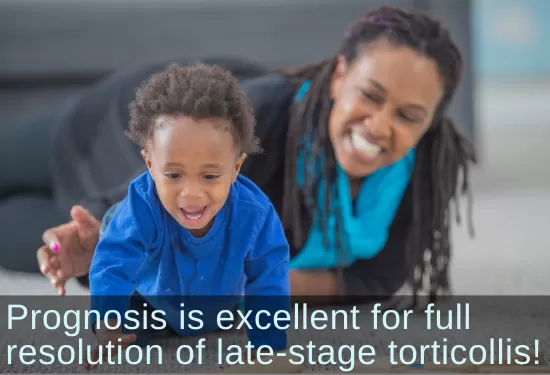Primitive Reflex Integration Tools for Physical Therapy Professionals
Physical therapy professionals can earn CEUs for Brain and Sensory Foundations, First Level and Second Level courses.
Go here for full information about CEUs for PTs and PTAs.
In the Brain and Sensory Foundations training courses, we focus on neurodevelopmental movements. Neurodevelopmental movements are the innate developmental, rhythmic, primitive reflex, and postural reflex movements of early infancy and childhood. Physical Therapists utilize these neurodevelopmental movements for assessment and intervention for patients of all ages to improve balance, posture, muscle strength, stamina, coordination, and overall function.
Incomplete primitive reflex development is associated with the following physical challenges:
- Balance deficits (Bob et al., 2021; Niklasson, et al., 2017; Wahlberg & Ireland, 2005)
- Coordination issues (Gieysztor et al., 2020; Grzywniak, 2017; Niklasson et al., 2017)
- Gross motor deficits (Preedy et al., 2022; Pecuch et al., 2021; Gieysztor et al., 2018)
- Fine motor deficits (Brown, 2010)
- Abnormal walking gait (Gieysztor et al. 2020)
- Visual motor skills deficits (Domingo-Sanz, 2022; Andrich et al., 2018; Gonzales et al., 2008; McPhillips et al., 2000)
Using Neurodevelopmental Movements Can Help Improve Physical Skills
"…developmental movements (i.e. those that mimic the movements that the child should have done as a baby) are essential in inhibiting primitive reflexes and, in turn, in allowing children to reach their physical development potential" (Preedy, et al., 2022, p. 290).
The following research supports what PT professionals are seeing: Using innate rhythmic movements and primitive reflex integration appears to help with the following physical challenges:
- Fine motor skills (Brown, 2010)
- Visual motor skills (Domingo-Sanz, 2022; Andrich et al., 2018; Gonzales et al., 2008; McPhillips et al., 2000)
- Balance (Grzywniak, 2017; Niklasson et al., 2017; Wahlberg & Ireland, 2005)
- Coordination (Grzywniak, 2017; Niklasson et al., 2017)
- Motor skills (Pecuch, et al., 2021)
"Children with increased reflex activity presented a lower level of motor efficiency…[with] the decrease in the level of reflex activity, the motor skills of children improved" (Pecuch, et al., 2021, p.1).
The Brain and Sensory Foundations CEU course offers PTs and PTAs a variety of intervention strategies and a range of appropriate tools for all ages.
See examples of case studies from PT professionals using the Brain and Sensory Foundations tools.
This 30-month-old toddler was referred to PT because her left foot was turning in. After only 8 sessions using tools from the Brain and Sensory Foundations program, her foot no longer turned in and she was able to jump, climb stairs, and ride a bike! Read about her massive improvements in gross motor development after receiving innate rhythmic movements.
This 12-year-old girl with spastic quadraparetic Cerebral Palsy made huge gains in using her gait trainer, standing without external supports, and making easier wheelchair transitions. Find out how her physical therapist helped her using tools from the Brain and Sensory Foundations course.
After just 4 weeks of rhythmic movements and primitive reflex integration, this delayed 20-month-old toddler went from only scooting on her bottom to walking! See how rhythmic movements can help with gross motor skills!
Brain and Sensory Foundations tools help this 13-month-old boy struggling with late-stage torticollis and underdeveloped postural reflexes. After 6 sessions his postural reflexes had developed, and the torticollis was substantially reduced.
Here are more case studies by PTs and PTAs using rhythmic movements and primitive reflex integration to help their clients.
What physical therapists say about the Brain and Sensory Foundations continuing education course in primitive reflex integration:
"As a pediatric PT, this course has really opened my eyes and made my observation techniques, evaluation, and treatment plans so much more effective and individualized.”
Linda Ferraro, MSPT"I have seen more progress in my medically fragile kids with these movements than anything else I have ever done professionally."
Brittany Hensley, PT, DPT"I have been a PT for over 20 years and have specialized training in many modalities. Working with rhythmic movements and reflex integration has revolutionized my practice. I have seen wonderful results with my adult orthopedic clients."
Marion Klein, PT"The information presented here is life changing! It was instantly applicable to my patients (children, teens and adults) as well as a game changer in the life of my own son. This not only has become a standard part of my treatment but a staple part of my conversation.
Thank you!"
Crystal T. Miller, PT, DPT
Reflex integration, including innate rhythmic movement is, “. . . the most valuable thing I have ever learned in my entire career.”
Melody Edwards, PT
In this video, Melody describes 3 case studies involving children with torticollis, developmental delay, and cerebral palsy (11 minutes).
Enjoy this amazing video!
The combination of tools in the Brain and Sensory Foundations courses work synergisticly to effectively support physical activity, strength, and coordination. Get tools for transformation and help your clients thrive.
References
Andrich, P., Shihada, M. B., Vinci, M. K., Wrenhaven, S. L., & Goodman, G. D. (2018). Statistical relationships between visual skill deficits and retained primitive reflexes in children. Optometry & Visual Performance, 6(3).
Bob, P., Konicarova, J., & Raboch, J. (2021). Disinhibition of primitive reflexes in attention deficit and hyperactivity disorder: Insight into specific mechanisms in girls and boys. Frontiers in Psychiatry, 12.
Brown, C. G. (2010). Improving fine motor skills in young children: An intervention study. Educational Psychology in Practice, 269- 279.
Domingo-Sanz, V. A. (2022). Inhibition of Primitive Reflexes and Its Relationship with Visual Projection in Children and Adolescents. Optometry & Visual Performance, 10(4).
Gieysztor, E., Pecuch, A., Kowal, M., Borowicz, W., & Paprocka-Borowicz, M. (2020). Pelvic symmetry is influenced by asymmetrical tonic neck reflex during young children’s gait. International Journal of Environmental Research and Public Health, 17(13), 4759.
Gieysztor, E. Z., Choińska, A., & Paprocka-Borowicz, M. (2018). Persistence of primitive reflexes and associated motor problems in healthy preschool children. Archives of Medical Science, 14(1), 167-173.
Gonzalez, S. R., Ciuffreda, K., Hernandez, L. C., Escalante, J. B. (2008). The correlation between primitive reflexes and saccadic eye movements in 5th grade children with teacher-reported reading problems. Optometry and Vision Development, 39(3), 140-145.
Grzywniak, C. (2017). Integration exercise programme for children with learning difficulties who have preserved vestigial primitive reflexes. Acta Neuropsychologica, 15, 241-256.
Niklasson, M., Norlander, T., Niklasson, I., & Rasmussen, P. (2017). Catching-up: Children with developmental coordination disorder compared to healthy children before and after sensorimotor therapy. PloS One, 12(10).
Pecuch, A., Gieysztor, E., Wolańska, E., Telenga, M., & Paprocka-Borowicz, M. (2021). Primitive reflex activity in relation to motor skills in healthy preschool children. Brain Sciences, 11(8), 967.
Preedy, P., Duncombe, R., & Gorely, T. (2022). Physical development in the early years: The impact of a daily movement programme on young children’s physical development. Education 3-13, 50(3), 289-303.
Walhberg, T., & Ireland, D. (2005). Can replicating primary reflex movements improve reading ability? Optometry & Vision Development, 36(2).
Sonia Story, M.S. has been teaching neurodevelopmental movements since 2006.
Sonia developed the Brain and Sensory Foundations program to provide comprehensive training in neurodevelopmental movements—combining innate rhythmic movements, play, primitive reflexes, and postural reflexes.
She earned a Bachelor's degree in biology/psychology and a Master’s degree in Movement Sciences. She is the author of The Importance of Reflex Integration and the Evidence eBook, giving the rationale and evidence basis for using neurodevelopmental movements for helping with challenges such as ADHD, Sensory Processing Disorders, anxiety, emotional dysregulation, visual skill deficits, poor social skills, gross and fine motor delays and other neurodevelopmental and behavioral disorders.
Her work is featured in numerous podcasts, summits, and conferences, and in the books Almost Autism: Recovering Children from Sensory Processing Disorder; Special Ed Mom Survival Guide; Family Health Revolution; and Same Journey, Different Paths—Stories of Auditory Processing Disorder.
Sonia’s mission is to help children and families experience the profound benefits of neurodevelopmental and integrative movements for more functional and fulfilling lives.







